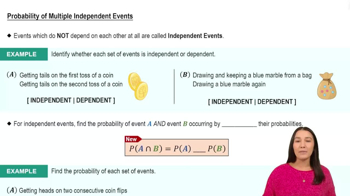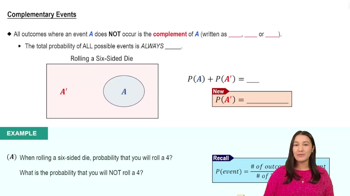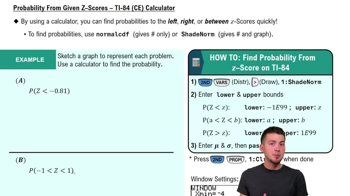Standard Tests Standard tests, such as the SAT or ACT or MCAT, tend to make extensive use of multiple-choice questions because they are easy to grade using software. If one such multiple choice question has possible correct answers of a, b, c, d, e, what is the probability of a wrong answer if the answer is a random guess?
Table of contents
- 1. Intro to Stats and Collecting Data1h 14m
- 2. Describing Data with Tables and Graphs1h 55m
- 3. Describing Data Numerically2h 5m
- 4. Probability2h 16m
- 5. Binomial Distribution & Discrete Random Variables3h 6m
- 6. Normal Distribution and Continuous Random Variables2h 11m
- 7. Sampling Distributions & Confidence Intervals: Mean3h 23m
- Sampling Distribution of the Sample Mean and Central Limit Theorem19m
- Distribution of Sample Mean - Excel23m
- Introduction to Confidence Intervals15m
- Confidence Intervals for Population Mean1h 18m
- Determining the Minimum Sample Size Required12m
- Finding Probabilities and T Critical Values - Excel28m
- Confidence Intervals for Population Means - Excel25m
- 8. Sampling Distributions & Confidence Intervals: Proportion1h 12m
- 9. Hypothesis Testing for One Sample3h 29m
- 10. Hypothesis Testing for Two Samples4h 50m
- Two Proportions1h 13m
- Two Proportions Hypothesis Test - Excel28m
- Two Means - Unknown, Unequal Variance1h 3m
- Two Means - Unknown Variances Hypothesis Test - Excel12m
- Two Means - Unknown, Equal Variance15m
- Two Means - Unknown, Equal Variances Hypothesis Test - Excel9m
- Two Means - Known Variance12m
- Two Means - Sigma Known Hypothesis Test - Excel21m
- Two Means - Matched Pairs (Dependent Samples)42m
- Matched Pairs Hypothesis Test - Excel12m
- 11. Correlation1h 6m
- 12. Regression1h 50m
- 13. Chi-Square Tests & Goodness of Fit1h 57m
- 14. ANOVA1h 57m
4. Probability
Complements
Problem 3.1.19
Textbook Question
Finding the Probability of the Complement of an Event In Exercises 17-20, the probability that an event will happen is given. Find the probability that the event will not happen.
19. P(E)=0.03
 Verified step by step guidance
Verified step by step guidance1
Step 1: Understand the concept of the complement of an event. The complement of an event E, denoted as E', represents all outcomes in the sample space that are not part of event E. The sum of the probabilities of an event and its complement is always equal to 1.
Step 2: Recall the formula for the probability of the complement of an event: \( P(E') = 1 - P(E) \). This formula is derived from the fact that \( P(E) + P(E') = 1 \).
Step 3: Identify the given probability of the event \( P(E) \). In this problem, \( P(E) = 0.03 \).
Step 4: Substitute the given value of \( P(E) \) into the formula for \( P(E') \): \( P(E') = 1 - 0.03 \).
Step 5: Simplify the expression to find \( P(E') \). This will give you the probability that the event will not happen.
 Verified video answer for a similar problem:
Verified video answer for a similar problem:This video solution was recommended by our tutors as helpful for the problem above
Video duration:
1mPlay a video:
Was this helpful?
Key Concepts
Here are the essential concepts you must grasp in order to answer the question correctly.
Probability of an Event
Probability quantifies the likelihood of an event occurring, expressed as a number between 0 and 1. A probability of 0 indicates impossibility, while a probability of 1 indicates certainty. In this case, P(E) = 0.03 means there is a 3% chance that event E will occur.
Recommended video:

Probability of Multiple Independent Events
Complement of an Event
The complement of an event refers to all outcomes in which the event does not occur. It is denoted as P(E') and can be calculated using the formula P(E') = 1 - P(E). This concept is essential for determining the probability of an event not happening based on the probability of it happening.
Recommended video:

Complementary Events
Calculating Complement Probability
To find the probability of the complement of an event, subtract the probability of the event from 1. For example, if P(E) = 0.03, then P(E') = 1 - 0.03 = 0.97. This means there is a 97% chance that event E will not occur, illustrating how to effectively use the complement rule in probability.
Recommended video:
Guided course

Probability From Given Z-Scores - TI-84 (CE) Calculator

 4:23m
4:23mWatch next
Master Complementary Events with a bite sized video explanation from Patrick
Start learningRelated Videos
Related Practice
Textbook Question
